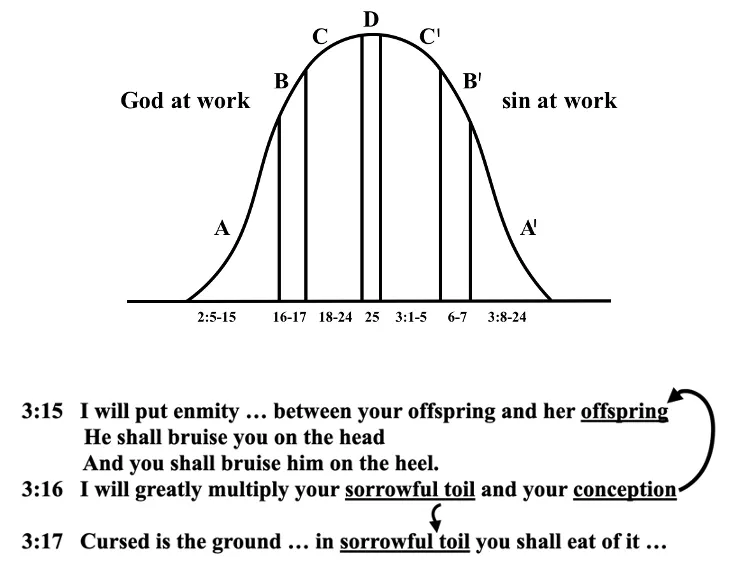
How the Hebrew Text of Genesis 3:16a Can Be Translated.
by Joy Fleming, PhD, PsyD
Genesis 3:16a can be translated as follows:
I will greatly multiply your sorrowful toil and your conception.
With sorrow you will bring forth children.
Your desire is for your husband,
But he will rule over you.
Rationale: It is suggested that the translation reflect the rhetorical devices used by the Biblical author, as explained below and in the references noted. [1]
Genesis 2:5-3:24 is written in a chiastic structure of 7 episodes.
In Genesis 3:16, God will greatly multiply not one thing but two things.
- I will greatly multiply (a) your sorrowful toil (b) and your conception.
There is an “interlocking crossover point,” [2] which I have called a “linchpin construction” present in Genesis 3:16a which requires the spelling out of the two elements connected by the conjunction “and.” There is no hendiadys at work here. God will multiply her ‘itsabon and her heron.
The author uses a linchpin construction in Genesis 3:15-17. In a linchpin construction, one word “points forward” to the use of the same word shortly thereafter; another word “points back” to a similar word used shortly before.
There is a linchpin construction in Genesis 3:15-17; and a linchpin construction in Genesis 2:7-9 which was observed by Isaac Kikawada.[3] The two linchpins are found in Episode A and Episode A’ of this Garden of Eden narrative.
Clarification on the meaning of ‘itsabon: ‘itsabon has a very precise meaning; it is not a generic term. ‘itsabon is only found 3 times in the Old Testament: Genesis 3:16, 3:17 and 5:29 (all in Genesis). Each time it relates to the curse on the ground.
In 3:17, God curses the ground and explains that the man will experience ‘itsabon (sorrowful toil) when he works the ground to wrest food from it to eat.
- To the man He said, …Cursed is the ground for your sake; in ‘itsabon (sorrowful toil) you shall eat of it all the days of your life…. Genesis 3:17
In 5:29, the curse on the ground, and the subsequent sorrowful toil needed to work the ground in order to have food to eat, are both tied together.
- And he called his name Noah, saying, “This one will comfort us concerning our work and the ‘itsabon (sorrowful toil) of our hands, because of the ground which the Lord has cursed.” Genesis 5:29:
In 3:16, God is giving a proleptic prophecy, fulfilled in 3:17 when God curses the ground. The same implications for the man, explained in 3:17 and described in 5:29, apply to the woman in 3:16. She too will have sorrowful toil in wresting food to eat from the ground which the Lord God is about to curse. (This is not about childbirth.)
The message in 3:16a is a message of bad news and good news:
I will greatly multiply (bad news🙂 your sorrowful toil in working the ground I’m about to curse
and (good news🙂 I will multiply your conception.
“Sorrowful toil” seems a better translation for ‘itsabon in Genesis 3:16, 3:17, and 5:29 rather than “sorrow” or “toil” or “pain” because ‘itsabon does not have a general sense. ‘itsabon is unique in that it is tied directly to the curse on the ground. Therefore it merits a clear demarcation distinguishing it from other terms (such as ‘etseb in 3:16b, as is explained in the blog post on 3:16b).
Clarification on the meaning of heron. Conception (or pregnancy)
This is good news. She (and the man) will still fulfill the creation mandate of Genesis 1:28 (Be fruitful and multiply; fill the earth and subdue it.) rather than “keeling over” immediately. She/they might have wondered if that would happen since God had promised they would surely die. God is telling the woman: You will still have children. But more than that, her multiplied heron points back to the good news of the protevangelium in 3:15 – She will have offspring that will defeat her (and God’s) enemy.
Genesis 3:16a is a complete thought and Genesis 3:16a should end with a period. Line a is a complete statement and is the center of the linchpin of 3:15-17. In Genesis 3:16a, God takes direct action. In 3:16b-d, God takes no further action. God simply describes to the woman what the new sinful world will be like. To end line a with a semi-colon makes line b look like a run-on sentence. And makes it look like it should be linked with line a, when it should not.
Joy Fleming, Tru316 Foundation, Tru316.com
[1] See Joy Fleming, A Rhetorical Analysis of Genesis 2–3 with Implications for a Theology of Man and Woman, PhD dissertation, University of Strasbourg, France, 1987. See also Man and Woman in Biblical Unity: Theology from Genesis 2-3, Westbow Press: Bloomington, IN, 2013.
[2] Isaac Kikawada in “The Shape of Genesis 11:1-9” in Rhetorical Criticism: Essays in Honor of James Muilenburg, ed. Jared J. Jackson and Martin Kessler (Pittsburgh: The Pickwick Press, 1974), pp. 19-24.
[3] Ibid. Kikawaka also noted there was a “interlocking crossover point” (linchpin) in Genesis 11:5 in the center of the Tower of Babel narrative.

